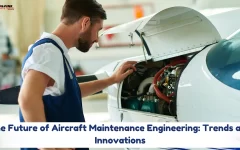Aircraft Maintenance Engineering (AME) Entrance Exams in India: A Comprehensive Guide
2024-11-20 8:16Aircraft Maintenance Engineering (AME) Entrance Exams in India: A Comprehensive Guide

Aircraft Maintenance Engineering (AME) Entrance Exams in India: A Comprehensive Guide
Aircraft Maintenance Engineering (AME) is a highly specialized and rewarding career path that plays a vital role in ensuring the safety and operational readiness of aircraft. In India, the demand for qualified AMEs is growing rapidly with the expansion of the aviation sector. For aspiring candidates, understanding the entrance exam process is essential to make informed decisions about their education and career in this field.
What is Aircraft Maintenance Engineering (AME)?
Aircraft Maintenance Engineering (AME) involves the inspection, repair, and maintenance of aircraft, engines, and associated systems to ensure they meet safety standards and are airworthy. AMEs work closely with aviation engineers and mechanics and are certified to perform checks and repairs on aircraft structures, systems, and engines.
In India, an AME is required to hold a valid license issued by the Directorate General of Civil Aviation (DGCA) to work professionally in the aviation sector.
Popular AME Entrance Exams in India
To become an Aircraft Maintenance Engineer in India, students must undergo training at a DGCA-approved AME training institute. Admission to these institutes is typically based on an entrance exam, followed by an interview or counseling session. Below are some of the most popular AME entrance exams in India:
A. The AME CEE (AME Common Entrance Exam)
Examination is a prestigious national-level entrance exam that provides aspiring students with a unique opportunity to embark on a career in the aviation sector. It serves as a gateway for students who are passionate about aviation and wish to explore various career options within the field.
The examination not only facilitates admission to Aircraft Maintenance Engineering (DGCA, EASA or UGC) programs but also opens doors to other courses in the field of aviation, including Aeronautical Engineering, Aerospace Engineering, Commercial Pilot License (CPL), Bachelor of Business Administration (BBA) in Aviation, Bachelor of Science (B.Sc) in Aircraft Maintenance Engineering, Cabin Crew, Ground Staff, and Airport Management.
Eligibility:
- Minimum age of 17 years.
- 10+2 with Physics, Chemistry, and Mathematics or an equivalent qualification.
- Alternatively, candidates with an engineering diploma or degree in aeronautical, electrical, mechanical, or electronics engineering are also eligible.
B. Admission through Individual Institute Exams
Several institutes across India conduct their own entrance exams for AME courses. Some of the prominent institutes that may conduct their exams include:
- Indira Gandhi Institute of Aeronautics (IGIA)
- Capt. Sahil Khurana Aviation Academy
- Rajiv Gandhi Aviation Academy
- Hindustan Aviation Academy
- Institute of Aeronautics and Engineering (IAE)
These institutes might have varying eligibility criteria, exam formats, and admission processes, but they typically focus on assessing the candidate’s basic knowledge in Physics, Chemistry, and Mathematics.
C. State-Level and University-Level Entrance Exams
In addition to national exams like AME CEE, some state governments and universities also conduct their own entrance exams or offer direct admissions based on 10+2 marks for AME courses.
Eligibility Criteria for AME Entrance Exams in India
The eligibility criteria for AME entrance exams in India can vary slightly depending on the specific exam or institute.
Educational Qualification:
Candidates must have completed their 10+2 with subjects like Physics, Chemistry, and Mathematics from a recognized board. Some institutes also accept students who have completed a diploma in engineering.
Age Limit:
The minimum age for appearing in AME entrance exams is generally 17 years. Some exams may have an upper age limit of 25 years, while others may have no upper age restriction.
Physical Fitness:
Since AME professionals work in physically demanding environments, candidates must be in good health, with no major physical disabilities that could hinder their ability to perform tasks.
Exam Pattern and Syllabus
The entrance exams for AME courses generally have a well-defined structure. Here’s a breakdown of what you can expect:
A. Exam Structure
Mode of Exam:
Most AME entrance exams are conducted offline (pen and paper-based), although some institutes may offer online exams.
Type of Questions:
The questions are mostly objective (MCQs), testing the candidates’ aptitude in key areas related to Physics, Chemistry, and Mathematics.
Duration:
The exams usually last for 2 to 3 hours.
Marking Scheme:
Correct answers typically earn 1 mark, while wrong answers may incur a negative marking of 0.25 to 0.5 marks, depending on the exam.
B. Syllabus
The syllabus for AME entrance exams typically includes:
Physics:
Mechanics, Thermodynamics, Electricity and Magnetism, Optics, etc.
Mathematics:
Algebra, Calculus, Trigonometry, Probability, etc.
Chemistry:
Atomic Structure, Organic Chemistry, Chemical Reactions, etc.
For candidates applying to specialized areas such as avionics or aircraft structures, there may be additional topics related to aircraft systems, electronics, and engineering mechanics.
Preparation Tips for AME Entrance Exams
To increase your chances of success in AME entrance exams, follow these essential preparation tips:
Understand the Exam Pattern:
Thoroughly understand the exam format, types of questions, and syllabus. Practice previous years’ papers and mock tests to familiarize yourself with the exam pattern.
Strong Foundation in Subjects:
Focus on building a solid understanding of Physics, Chemistry, and Mathematics. Use NCERT textbooks and reference materials to strengthen your concepts.
Time Management:
During the exam, time management is crucial. Practice solving questions within the given time limit and avoid spending too much time on difficult questions.
Stay Updated:
Keep track of the latest updates and announcements related to AME entrance exams. Regularly check official websites for exam dates, eligibility criteria, and application forms.
Career Opportunities for AMEs in India
After completing AME training and obtaining a DGCA license, graduates can pursue careers in various sectors of the aviation industry, including:
Commercial Airlines:
Working as a certified AME to maintain and repair aircraft in service.
Private Jet Operators:
Maintaining private and chartered aircraft.
Aviation Maintenance Companies:
Working with third-party contractors who handle aircraft maintenance for various airlines.
Aircraft Manufacturing Companies:
Involvement in the design and testing phases of new aircraft models.
Additionally, qualified AMEs can explore opportunities abroad, as the demand for aviation professionals is global.
Conclusion
Pursuing a career as an Aircraft Maintenance Engineer offers tremendous career prospects in India and abroad. The right preparation for the entrance exams can set you on the path to success. With the increasing growth of the aviation sector in India, becoming an AME can open doors to exciting opportunities in the aviation industry.
Aspiring candidates should start by focusing on their academic background in Physics, Chemistry, and Mathematics, and then choose the appropriate entrance exam to secure admission to a recognized AME training program. With determination, hard work, and the right training, you can make your mark in this high-demand field and contribute to the ever-evolving world of aviation.








